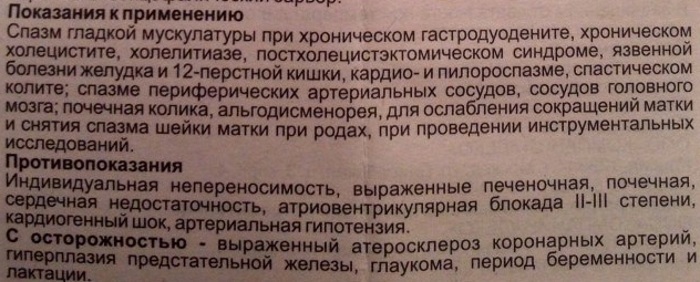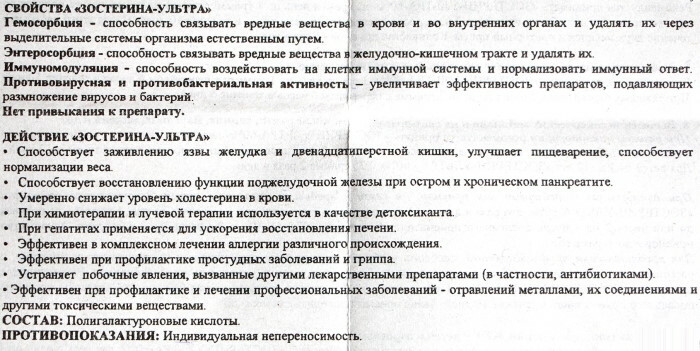Content
- What is the Shchetkin-Blumberg symptom, what is it characterized by
- Discovery history
- Importance in diagnosis
- What pathology means the presence of a symptom
- What the patient feels
- Algorithm for determining the symptom, how the abdominal cavity is palpated
- Positive and negative result
- With peritonitis
- With appendicitis
- When perforating
- With uremia
- With pneumonia
- With myocardial infarction
- With hemoperitoneum
- With acute pancreatitis
- With abdominal hematomas
- Doubtful symptom
- Confirmation of the diagnosis with a positive Shchetkin-Blumberg symptom
- Video about the Shchetkin-Blumberg symptom
Shchetkin-Blumberg symptom used by surgeons, gynecologists, therapists, traumatologists to conduct a quick examination of patients who complain of bouts of acute abdominal pain. With the help of this diagnostic technique, it is possible to detect the localization of the pathological process with the further implementation of a more detailed examination.
What is the Shchetkin-Blumberg symptom, what is it characterized by
The Shchetkin-Blumberg symptom is a preliminary diagnostic method, which is based on gentle palpation of the anterior peritoneal wall. In the process of palpating the surface of the patient's abdomen, the doctor assesses the severity of his pain.
During the examination, areas of tissue that are located in close proximity to the source of acute pain are exposed to accentuated palpation. According to the patient's emotional reaction, as well as his feelings, the doctor assesses the severity of the inflammatory process, the degree of tension of the spasmodic muscles. Depending on the localization of pain, a preliminary diagnosis is made, which requires instrumental confirmation.
Discovery history
The Shchetkin-Blumberg symptom was first discovered by the German surgeon Jacob Blumberg. The palpation technique, as well as the interpretation of the results of the examination of the peritoneum, were described in detail by this doctor in 1907.
Blumberg's scientific works formed the basis for the diagnosis of the internal organs of patients with attacks of acute pain inside the abdominal cavity. A year later, the obstetrician Shchetkin, being at a meeting of the Penza Medical Society, made a statement that he had used this examination technique back in the 80s of the nineteenth century.
Importance in diagnosis
The Shchetkin-Blumberg symptom is important for the preliminary diagnosis of the abdominal cavity. Patients who are admitted to the hospital of the surgical department with complaints of attacks of acute abdominal pain are examined by a doctor using this technique of gentle palpation.
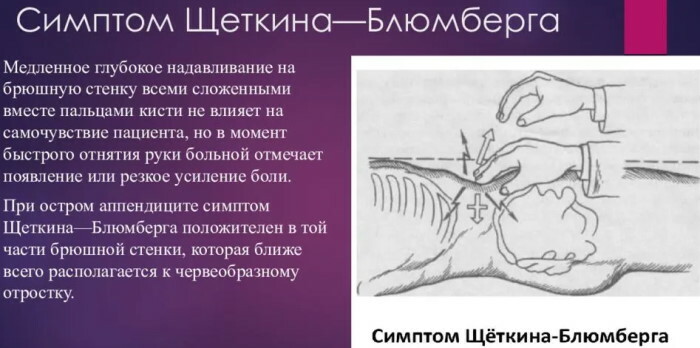
Applying the Shchetkin-Blumberg symptom, the doctor determines the localization of the pathological process, and then directs the patient for additional examination using MRI or ultrasound diagnostics. In urgent situations, the doctor can decide on the need for a surgical operation only based on the results of the Shchetkin-Blumberg symptom. For example, in case of detection of acute appendicitis, or perforation of an internal organ.
What pathology means the presence of a symptom
The Shchetkin-Blumberg symptom is a complex of painful signs, the presence of which indicates the possible presence of the following pathologies of the abdominal cavity and adjacent parts of the body:
- acute appendicitis;
- perforation of a hollow organ with further ingress of its contents into the voids of the abdominal cavity;
- peritonitis;
- pneumonia;
- myocardial infarction (the Shchetkin-Blumberg symptom is present at the initial stages of the development of a heart attack, when early diagnosis of cardiac pathology is possible);
- acute form of pancreatitis;
- hematoma in the anterior peritoneal wall;
- uremia;
- degenerative changes in the structure of peripheral nerves responsible for the innervation of the anterior abdominal wall;
- pseudo-abdominal syndrome;
- hemorrhage in the region in the retroperitoneal tissue.
It is believed that the Shchetkin-Blumberg symptom is most pronounced in patients with peritonitis and acute appendicitis. The presence of these abdominal pathologies is easily determined by an experienced surgeon using only one palpation.
What the patient feels
The nature of the patient's sensations depends on the type of disease, as well as the severity of the inflammatory process. Peritonitis, appendicitis, perforation of hollow organs cause attacks of acute cutting pain, which increases during palpation of the anterior abdominal wall. If a person has such sensations, the Shchetkin-Blumberg symptom is positive.
Patients with a negative examination result inside the abdomen may feel discomfort, but do not experience severe pain. Similar symptoms persist in a calm state, as well as following the results of gentle palpation of the muscles of the anterior abdominal wall. Extensive tissue inflammation can cause pain to spread throughout the peritoneum.
Algorithm for determining the symptom, how the abdominal cavity is palpated
The definition of the Shchetkin-Blumberg symptom is carried out in compliance with the following algorithm of actions:
- The patient takes a horizontal position, lying on his back.
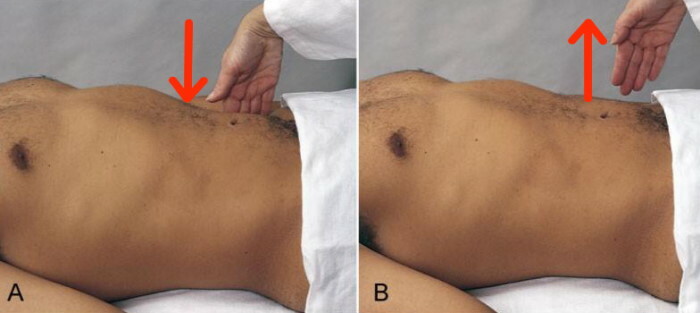
- The doctor frees access to the surface of the patient's abdomen by lifting his clothes.
- The doctor applies light pressure on the anterior wall of the abdominal cavity next to the source of discomfort, or directly in the area of localization of pathological symptoms.
- After squeezing the muscle tissue, the doctor abruptly removes his hand from the surface of the abdomen of the subject.
In patients with Shchetkin-Blumberg's symptom, at the moment of sudden cessation of palpation, an attack of acute pain occurs, as the muscles of the elastic abdominal wall contract. A similar reaction of the muscles and peripheral nerves indicates a positive diagnostic result. This outcome confirms the fact of the pathological process inside the peritoneum.
Positive and negative result
The Shchetkin-Blumberg symptom is an attack of acute cutting pain, which increases in response to palpation of the anterior abdominal wall. The saturation and prevalence of discomfort depends on the type of disease that provoked the pathological state of the body.
With peritonitis
The defeat of the parietal and visceral layer of the abdominal cavity leads to the spread of acute pain syndrome throughout the abdomen. With limited peritonitis, the Shchetkin-Blumberg symptom is determined only in the area of the inflammatory process.
The progression of the disease with damage to large areas of the parietal or visceral sheet causes an increase in pathological signs. With peritonitis, the presence of an attack of acute pain, which occurs in response to palpation of the abdomen, is considered to be a symptom of Shchetkin-Blumberg.

A negative examination result is the preservation of slight discomfort in a certain area of the abdominal cavity, or the complete absence of a negative reaction of the body in response to palpation of the abdomen.
The Shchetkin-Blumberg symptom caused by peritonitis is accompanied by the following additional signs:
- nausea;
- vomiting, after which the patient does not experience relief;
- hypertonicity of the muscles of the anterior wall of the peritoneum;
- increased pain in the abdomen during movement;
- painful sensations even with slight pressure on the surface of the anterior abdominal wall;
- fever and an increase in body temperature up to 37-38 degrees.
Patients with signs of peritonitis need urgent medical attention. The relief of the Shchetkin-Blumberg symptom is possible only after elimination of the causes of the inflammatory process, as well as surgical debridement of the foci of necrosis.
With appendicitis
In patients with signs of appendicitis, the manifestation of the Shchetkin-Blumberg symptom always has a standard localization. In the process of gentle palpation of the abdomen, the doctor discovers that the subject is experiencing acute pain in the iliac region on the right. Before the beginning of the palpation of the anterior wall of the peritoneum, the patient may experience moderate discomfort, but after pressing on the tissues near the appendicitis, he has an attack of acute pain.
This pathology is accompanied by the following additional symptoms:
- nausea;
- loss of appetite;
- fever;
- physical weakness;
- an increase in body temperature to a level of 37 degrees.

Symptom Shchetkin-Blumberg with appendicitis may not appear immediately. The main danger of this pathology is the risk of developing extensive tissue inflammation with the transition to total peritonitis.
When perforating
Violation of the integrity of the hollow organs of the abdominal cavity is one of the most severe pathologies, which carries a danger to the patient's life. Perforation of individual sections of the gastrointestinal tract is manifested by a rich Shchetkin-Blumberg symptom. Acute pain on palpation is present in all parts of the abdomen. Even a slight touch of the doctor to the anterior wall of the peritoneum causes an attack of unbearable pain in the patient, which forces the latter to involuntarily draw his knees to the body.
The Shchetkin-Blumberg symptom with perforation of the hollow organs of the abdominal cavity is manifested by the following additional signs:
- nausea;
- dizziness;
- opening of internal bleeding;
- lowering blood pressure;
- pallor of the skin;
- vomit.
Stabilization of a patient with similar symptoms requires urgent surgery to restore the integrity of the damaged organ. The ingestion of the contents of the gastrointestinal tract into the abdominal cavity causes the rapid development of extensive peritonitis with the risk of further death.
With uremia
Symptom Shchetkin-Blumberg, caused by uremia, has a mild manifestation. The intensity of the attacks of pain inside the abdominal cavity directly depends on the severity of the intoxication of the body. In patients with renal failure who do not receive adequate medication and hardware treatment, the work of the digestive tract is disrupted, and pleurisy develops.
On palpation of the central part of the abdominal cavity, the patient experiences acute pain, which intensifies as the body becomes intoxicated. With a negative Shchetkin-Blumberg symptom, discomfort is completely absent.
Uremia is manifested not only by the Shchetkin-Blumberg symptom, but also by the following additional signs:
- decrease in body temperature up to 35 degrees;
- prostration;
- headache;
- lethargy of thoughts;
- intense thirst;
- bleed-through of mineral salts on the surface of the skin (loss of uremic frost);
- nausea;
- loss of appetite;
- vomit;
- apathy.
Symptom Shchetkin-Blumberg with uremia is considered a severe complication of chronic intoxication of the body. Lack of treatment leads to the progression of pleurisy with the further development of peritonitis and increased pain in the abdominal cavity.
With pneumonia
Symptom Shchetkin-Blumberg, caused by pneumonia, is manifested by moderate pain in the upper abdominal region. The appearance of such a symptom is typical for patients with bilateral pneumonia with total damage to the lung tissue.
This pathology is manifested by the following additional features:
- an increase in body temperature up to 38-39 degrees;
- headache;
- dry cough;
- dyspnea;
- wheezing in the bronchi;
- physical weakness;
- dizziness;
- fever.
The appearance of the Shchetkin-Blumberg symptom in patients with pneumonia may indicate the development of a severe complication in the form of pleurisy. Patients with similar symptoms undergo a mandatory diagnostic examination using X-ray and MRI of the lungs.
With myocardial infarction
In patients with myocardial infarction, the Shchetkin-Blumberg symptom occurs in rare cases. A heart attack can cause severe pain in the center and left side of the chest that spreads to the upper abdomen. The patient experiences a prolonged burning sensation. Discomfort in the abdomen is replaced by bouts of acute pain at the time of palpation of the anterior peritoneal wall by the doctor.
The Shchetkin-Blumberg symptom caused by myocardial infarction is accompanied by the following additional signs:
- burning pain in the chest;
- dyspnea;
- cardiopalmus;
- unstable blood pressure;

- dizziness;
- severe muscle weakness;
- darkening in the eyes;
- light-headedness or complete loss of consciousness;
- cyanosis of the skin (this symptom is especially noticeable in the area of the triangle of the nose).
Myocardial infarction, accompanied by a symptom of Shchetkin-Blumberg, is dangerous with the onset of a lethal outcome. A patient with similar pathological signs should be admitted to a hospital in the cardiology department.
With hemoperitoneum
Symptom Shchetkin-Blumberg with hemoperitoneum is manifested by bouts of acute pain, which is present in all parts of the abdominal cavity. This pathology is characterized by the discovery of internal bleeding with the accumulation of large volumes of blood between the parietal and visceral peritoneum. Even a gentle palpation of the surface of the patient's abdomen causes an attack of acute and excruciating pain in the latter.
In most cases, the appearance of the Shchetkin-Blumberg symptom in hemoperitoneum has a traumatic etiology, and also differs in the following additional features:
- a sharp drop in blood pressure;
- dizziness;
- the appearance of cold sweats;
- fever;
- tachycardia;
- darkening in the eyes;
- light-headedness.
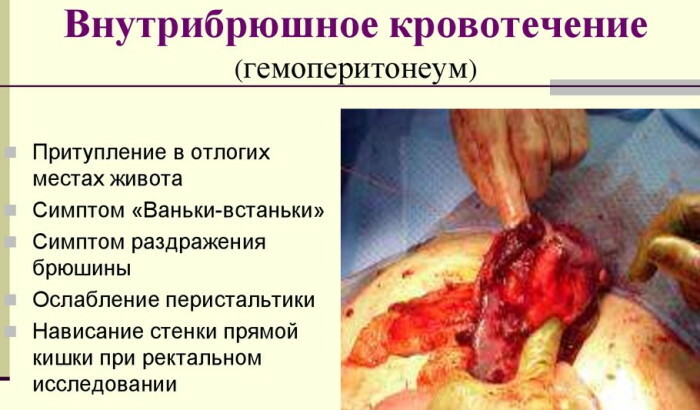
The clinical manifestations of this pathology and the intensification of the Shchetkin-Blumberg symptom indicate an unfavorable prognosis for the patient. In the absence of qualified surgical care, in 97% of cases, patients with hemoperitoneum die from acute blood loss and traumatic shock.
With acute pancreatitis
In patients with acute pancreatitis, the Shchetkin-Blumberg symptom is localized in the left hypochondrium, and also covers the central part of the peritoneum. An attack of acute pain occurs during palpation of this area of the abdomen, and also intensifies as it approaches the inflamed tissues of the pancreas. A Schetkin-Blumberg symptom with a negative result is a complete absence of pain, or the presence of minor discomfort.
Symptom Shchetkin-Blumberg in acute pancreatitis is manifested by the following additional signs:
- bloating;
- loss of appetite;
- girdle pain from the left hypochondrium to the iliac region on the left;
- nausea;
- flatulence;
- vomit;
- necrosis of the inflamed tissues of the pancreas;
- loss of consciousness.
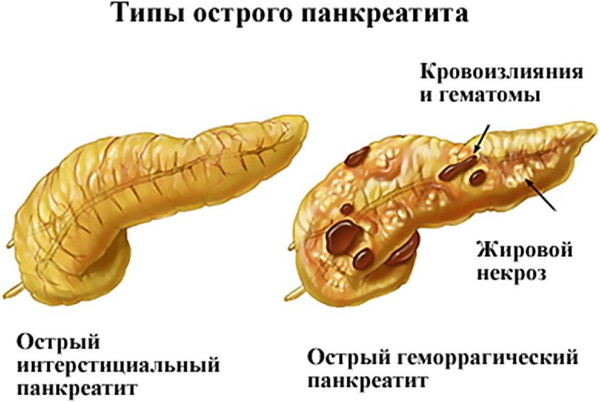
Patients with Shchetkin-Blumberg symptom, which is caused by acute pancreatitis, are immediately admitted to the hospital of a medical institution. The danger of this pathology lies in the risk of necrotic lesions of large areas of the pancreas.
With abdominal hematomas
With abdominal hematomas, the Shchetkin-Blumberg symptom manifests itself in the area of localization of internal bruising. The patient feels an increase in discomfort as the doctor's fingers approach the area of the injured peritoneum. With a negative Shchetkin-Blumberg symptom, abdominal pain should be completely absent.
Abdominal hematomas are manifested by the following additional signs:
- swelling of the anterior wall of the peritoneum;
- loss of appetite;
- feeling of heaviness in the abdomen;
- nausea;
- vomit;
- diarrhea.
With a bruise of the tissues of internal organs, a long-term health disorder is possible, as well as a temporary dysfunction of the injured parts of the body.
Doubtful symptom
The Shchetkin-Blumberg symptom is a diagnostic technique that can have not only positive, negative outcomes, but also a dubious option. A similar examination result occurs in cases when palpation of the anterior wall of the patient's abdomen does not cause severe pain, but at the same time he has a feeling of pronounced discomfort.
The dubious variant of the Shchetkin-Blumberg symptom indicates excessive overstrain of the muscle tissues of the peritoneum, bloating, and a potential risk of developing ascites. Patients with these results of palpation require additional examination to establish the causes of muscle spasm.
Confirmation of the diagnosis with a positive Shchetkin-Blumberg symptom
With a positive Shchetkin-Blumberg symptom, the patient feels acute pain in the area of inflammatory tissue damage, even if the adjacent peritoneal square is palpated. The presence of such signs of a pathological state of the body requires an additional examination to make a final diagnosis.
The table below describes the main methods of hardware and laboratory studies that are carried out in relation to patients with Shchetkin-Blumberg symptom.
| Diagnostic method | Average cost and essence of the survey |
| Ultrasound | An ultrasound of the abdominal cavity allows you to determine the localization of the inflammatory process, as well as to investigate the state of the tissues of the internal organs that are in the focus of the pathological process. The average cost of this diagnostic is 4400 rubles. |
| MRI | MRI is one of the most informative examination methods, which displays the state of the entire abdominal cavity. With the help of this diagnosis, the doctor detects not only foci of inflammation, injured tissue sites, but also assesses the risk of complications. The price of an MRI of the abdominal cavity is 11,500 rubles. |
| X-ray | An abdominal x-ray using a contrast agent is performed for patients who show signs of trauma to the hollow organs. This examination method can be used in the process of differential diagnosis. The average cost of an abdominal X-ray is 2300 rubles. |
To assess the severity of the inflammatory process, a clinical study of the patient's blood and urine is prescribed. In situations where there is objective suspicion of acute peritonitis and there is a risk of developing sepsis, the doctor prescribes a microbiological blood test for the patient to isolate strains of bacterial microflora. Based on the results of the examination, the doctor selects an effective course of drug and surgical treatment.
The Shchetkin-Blumberg symptom is a method of preliminary diagnosis of patients who complain of discomfort or pain inside the abdominal cavity. The principle of this examination is careful palpation of the abdomen in the immediate vicinity of the pathological focus. The doctor slowly probes the tissues of the anterior abdominal wall in the adjacent square from the source of pain.
The Shchetkin-Blumberg symptom is considered positive if, at the moment of relaxation of the doctor's hand, the patient experiences an acute pain syndrome in the focus of the pathological process. In the absence of such sensations, preservation of slight discomfort, the result of palpation is recognized as doubtful or negative.
Video about the Shchetkin-Blumberg symptom
Shchetkin-Blumberg symptom:


